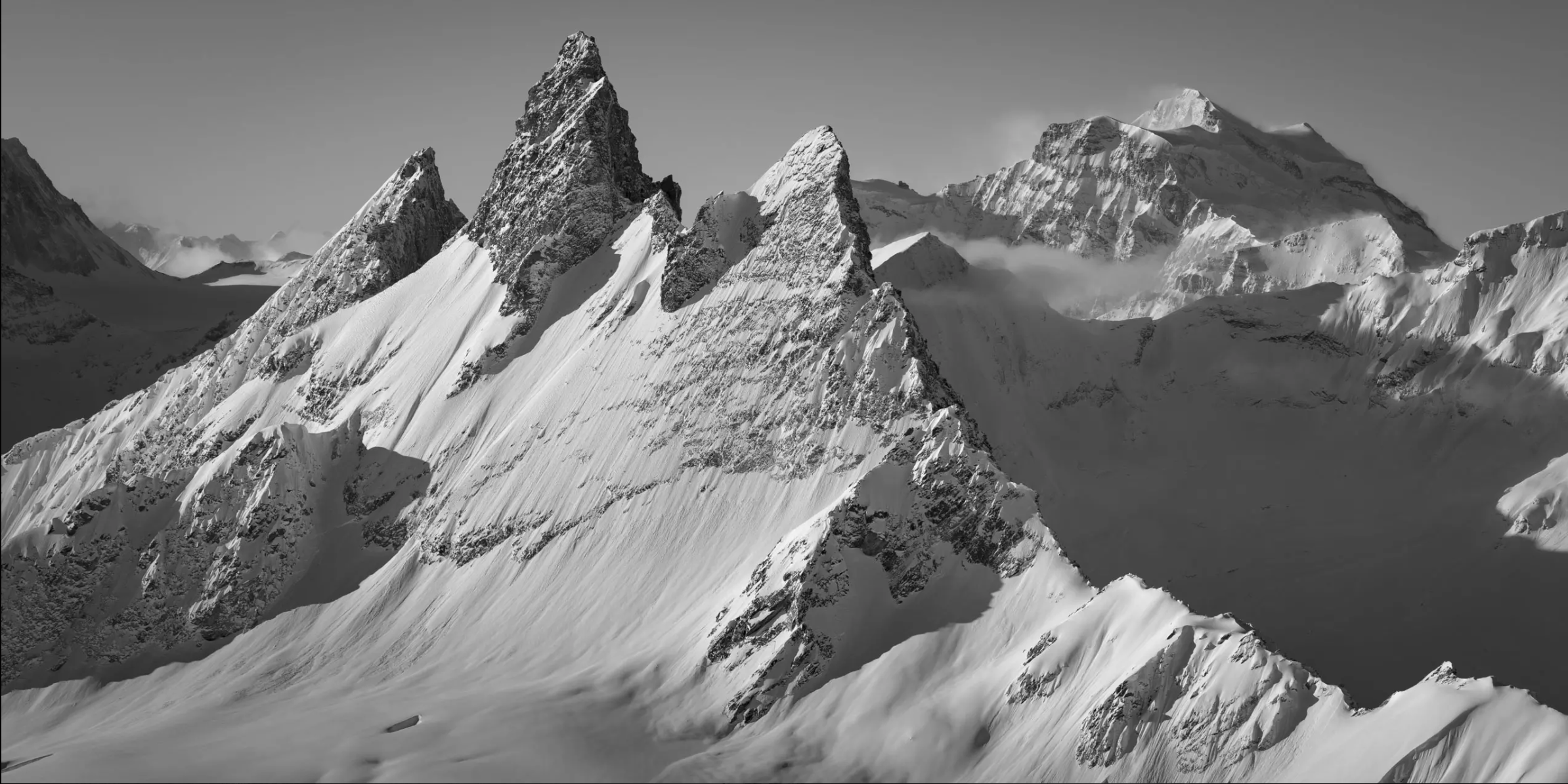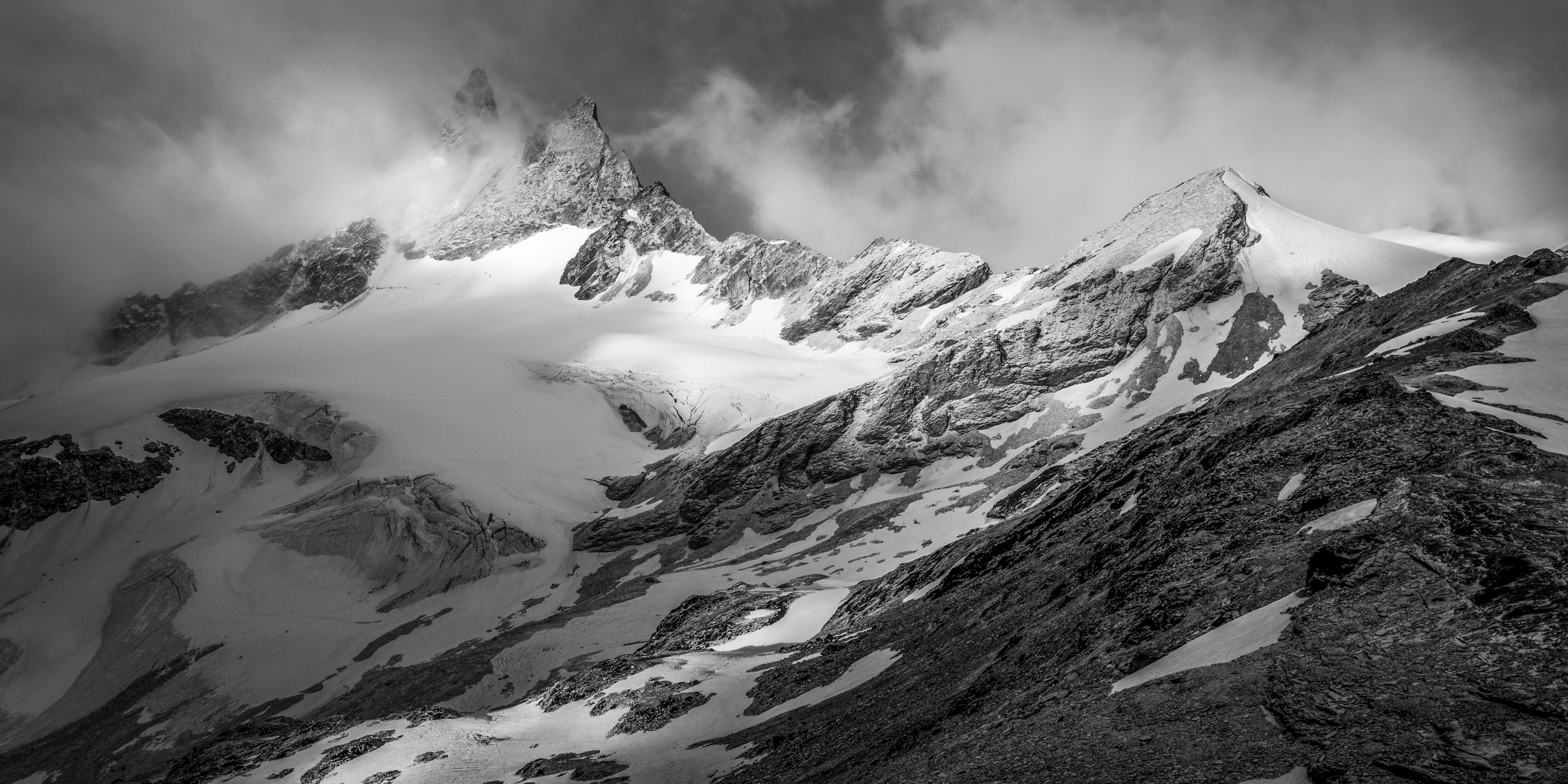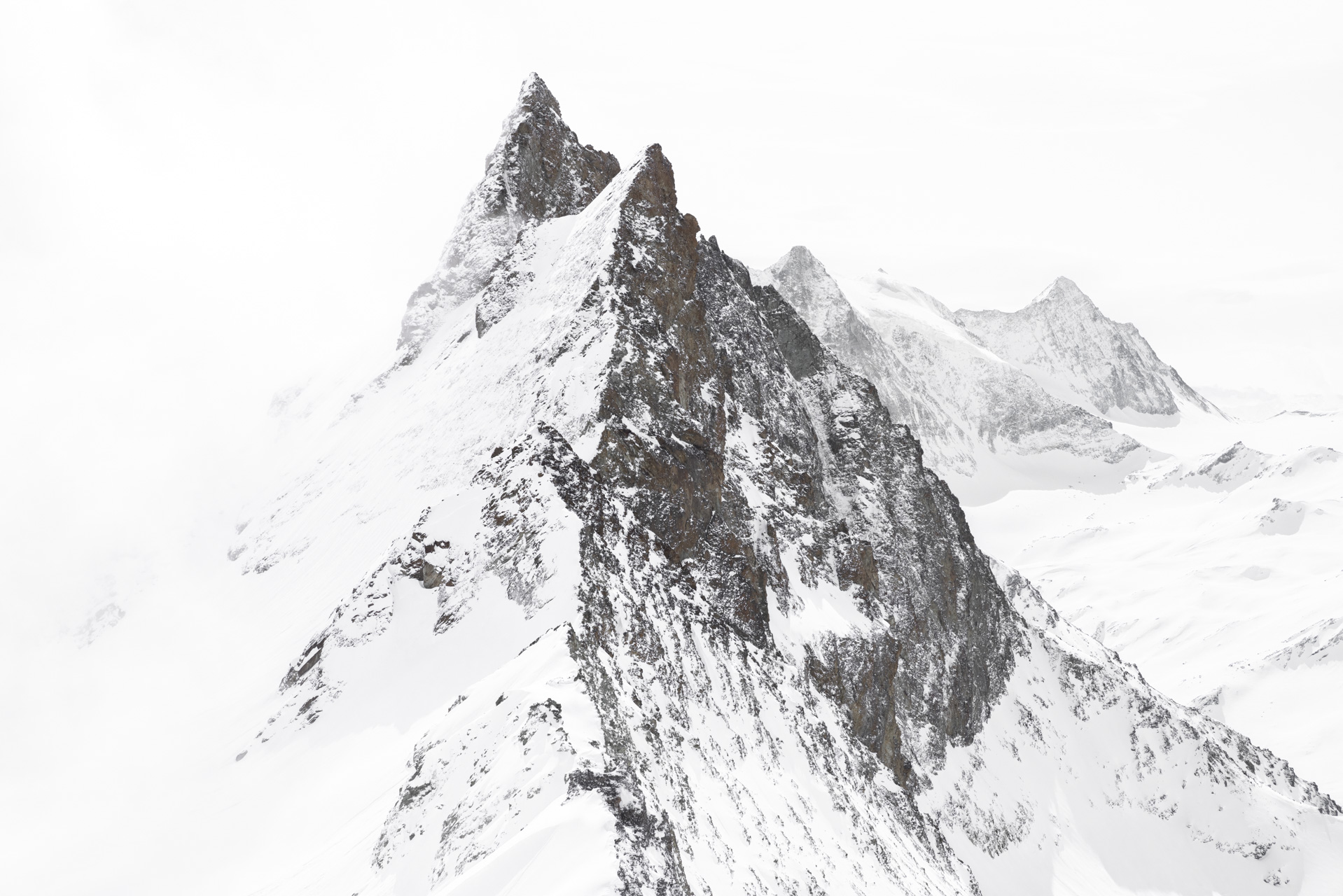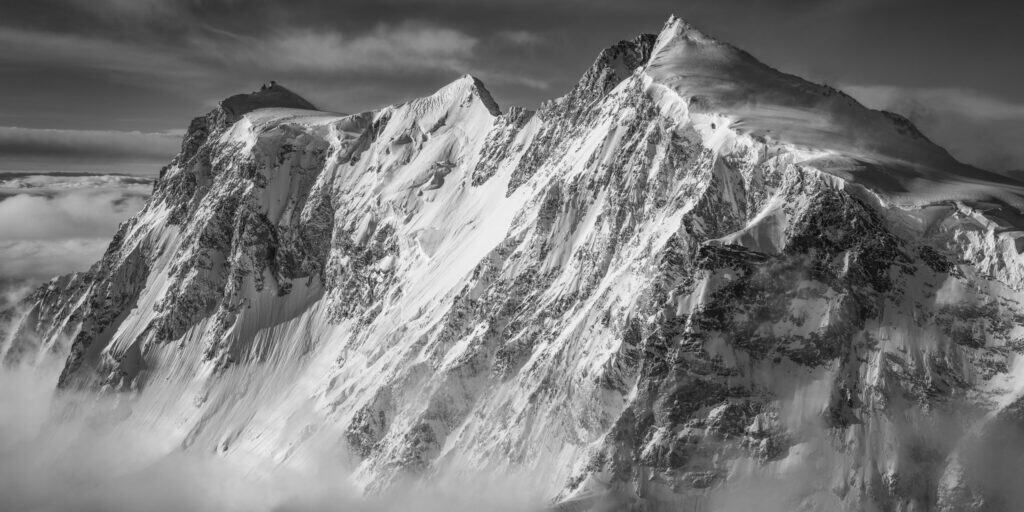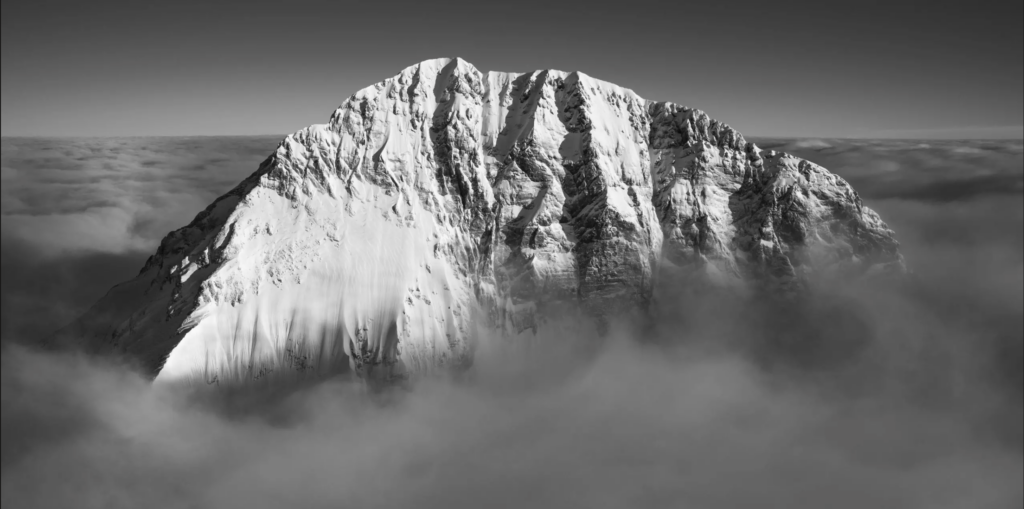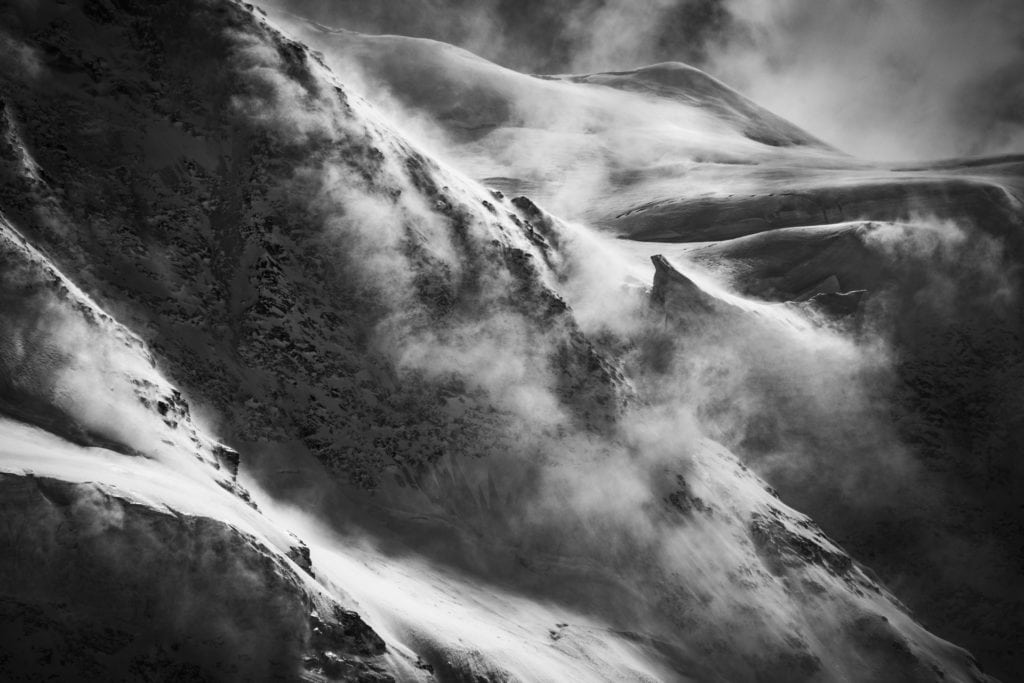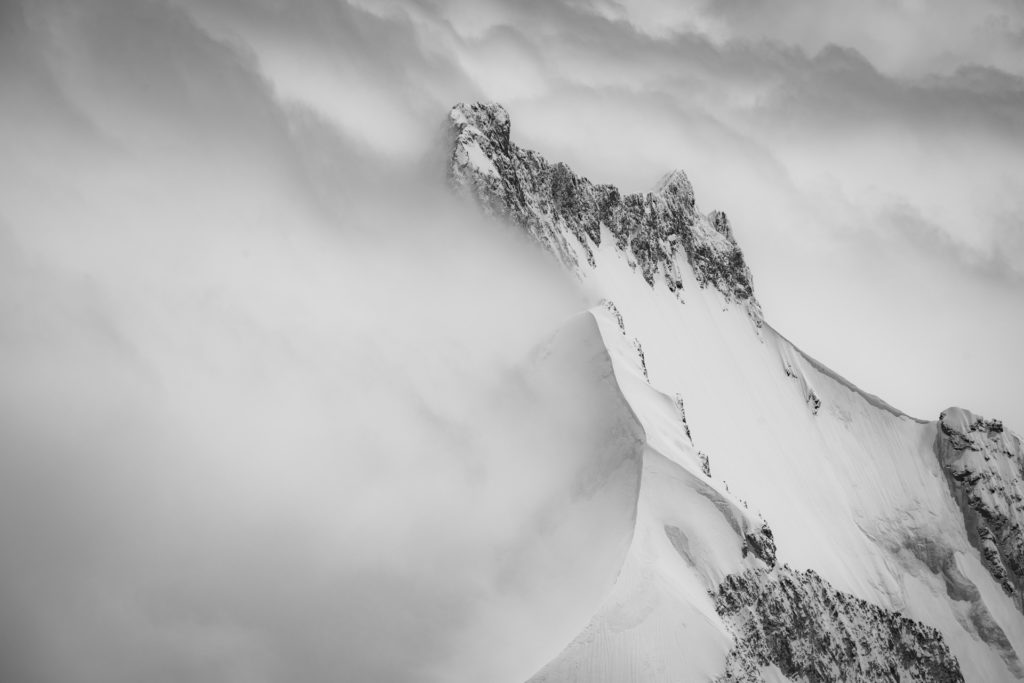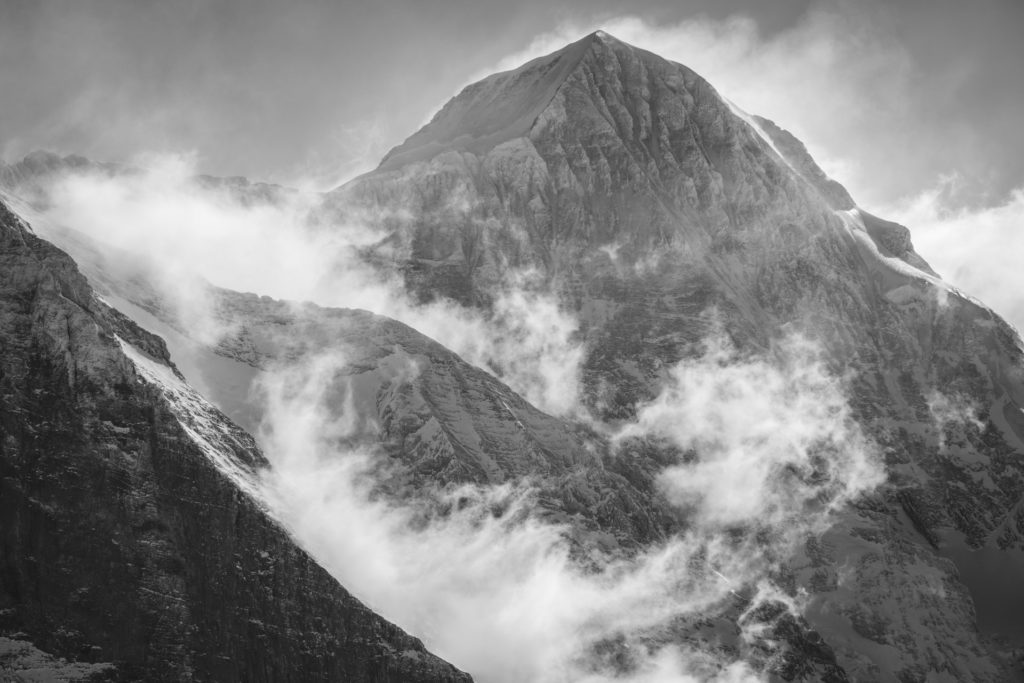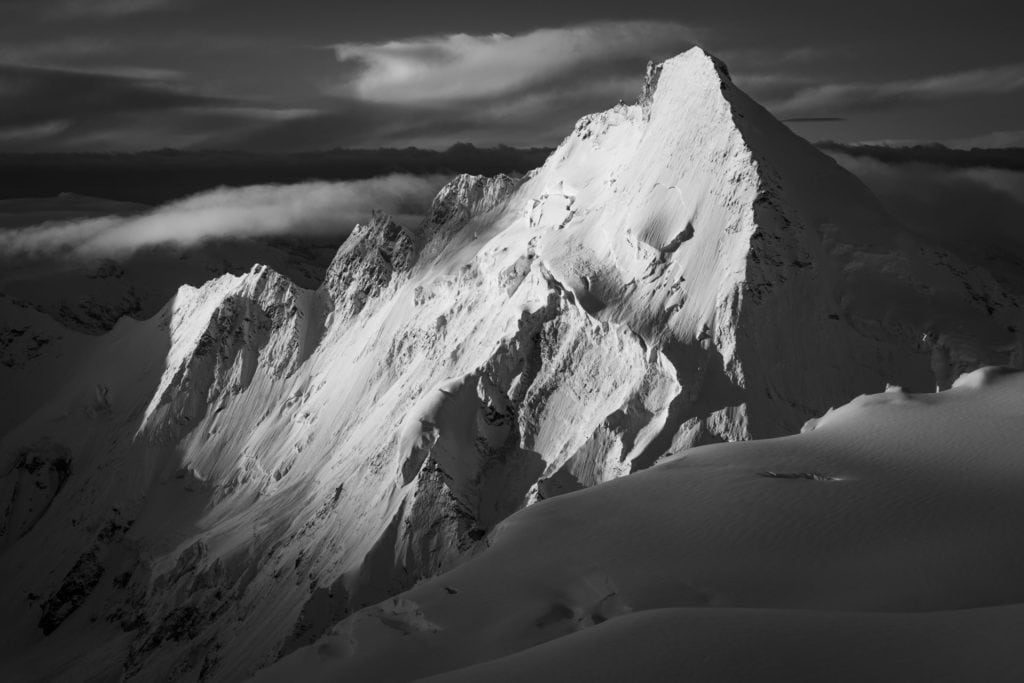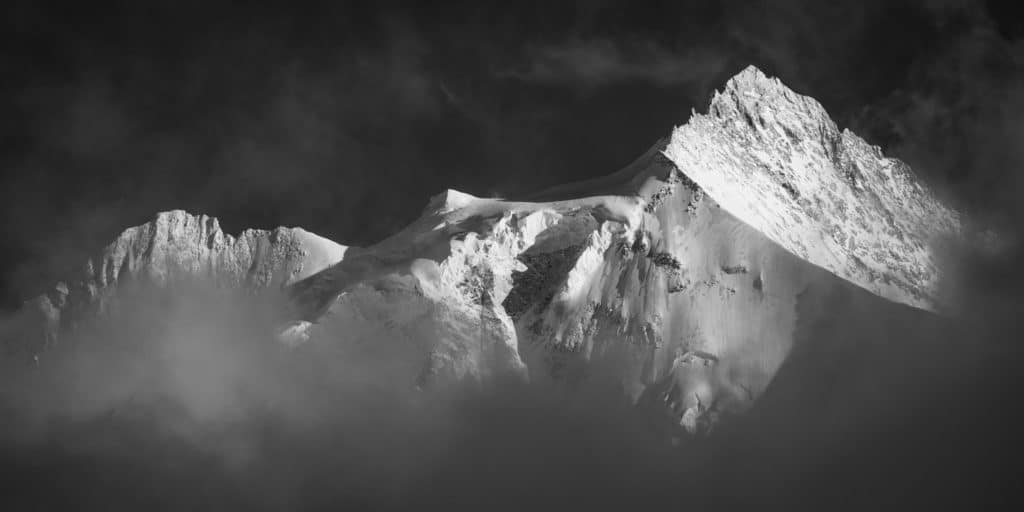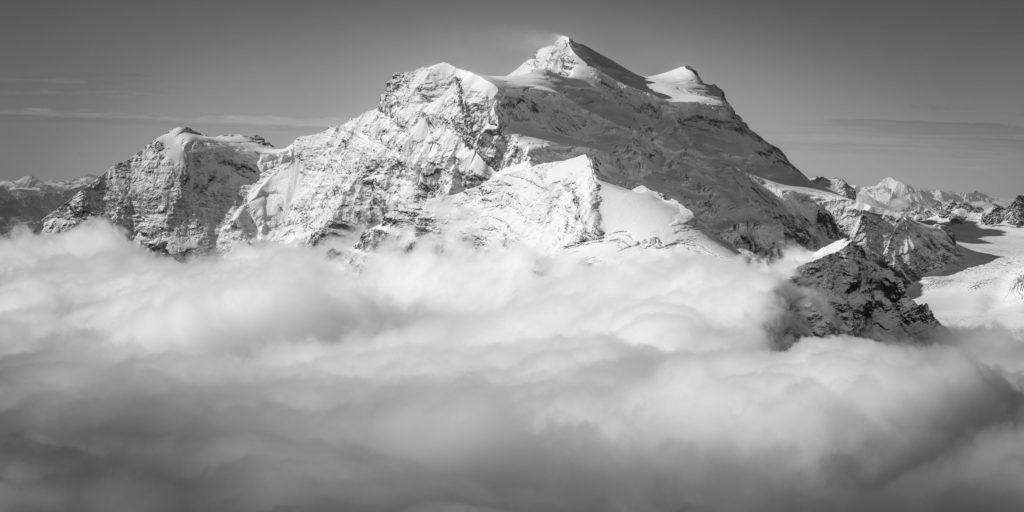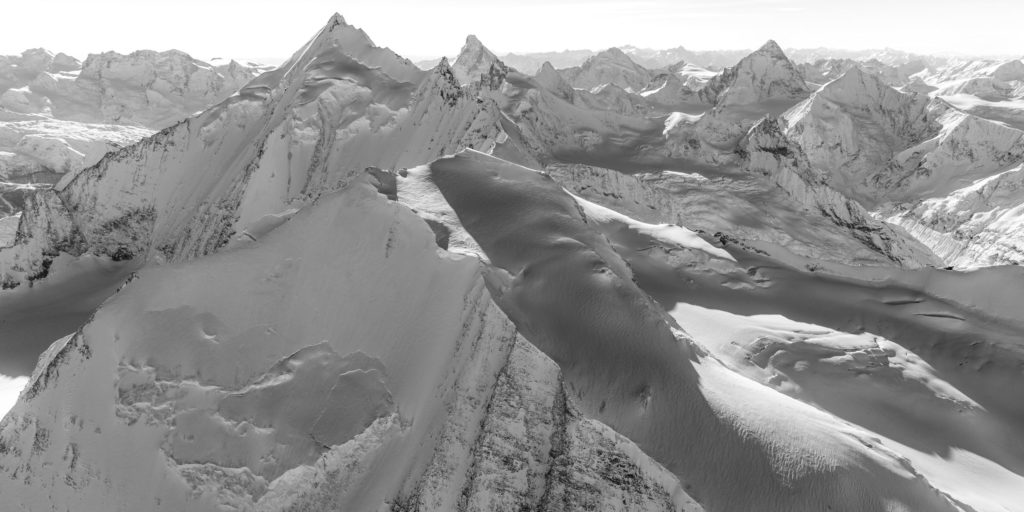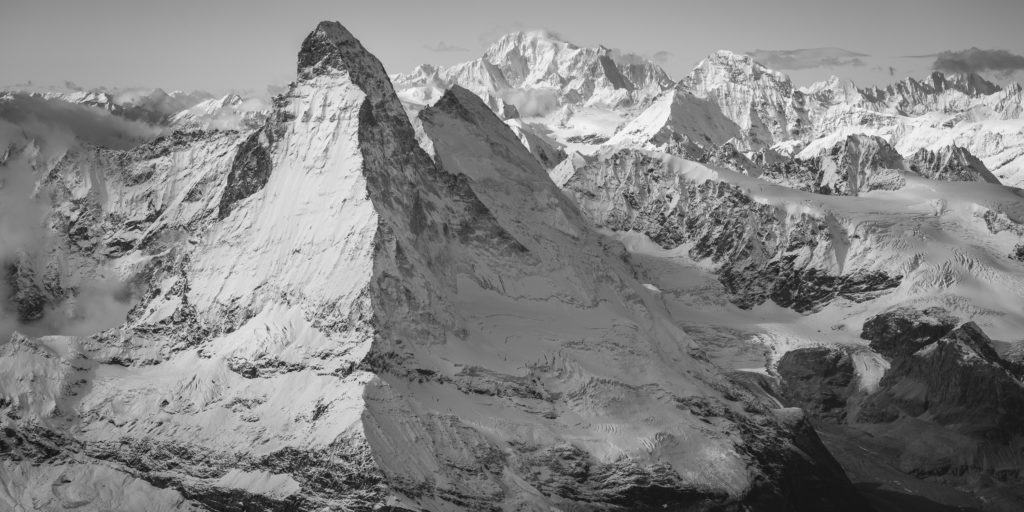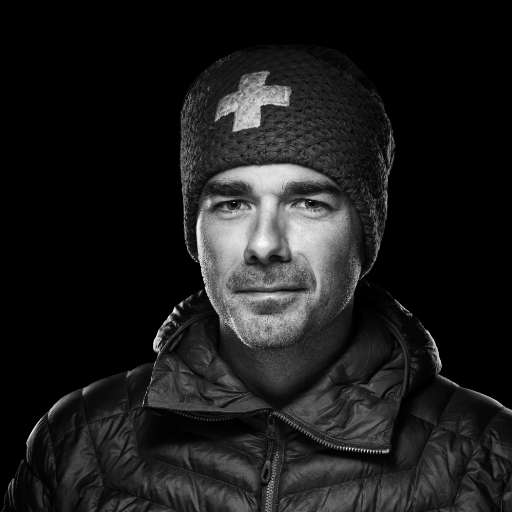The Valais Alps abound with gigantic, sublime mountains. But in the heart of this realm of rock and ice, nature has fashioned a massif without equal. Here, I present a portrait of the Aiguilles Rouges d'Arolla , a celestial journey to the gates of the sublime.
Portrait des Aiguilles Rouges d'Arolla : Birth of a colossal mountain
The Aiguilles Rouges d'Arolla blaze in the skies above the Swiss Valais. Born from the union of summits and breccias, they take flight between Lac des Dix and Val d'Arolla. This mountain range in the Valais Alps stretches from the Col des Ignes to the Col Sud des Darbonires. Overlooking the Darbonires and Aiguilles Rouges glaciers, it culminates at 3644 metres aboveArolla.
The Aiguilles Rouges form a thousand-year-old wall of rock, a vestige of a time when the mountain had not yet risen from the waters. This impregnable fortress of metagabbros proudly holds up its three highest bastions to show the world the grandeur of the Alps. From north to south, its peaks rise to altitudes of over 3,500 m, a far cry from the day when man would have the audacity to face them.
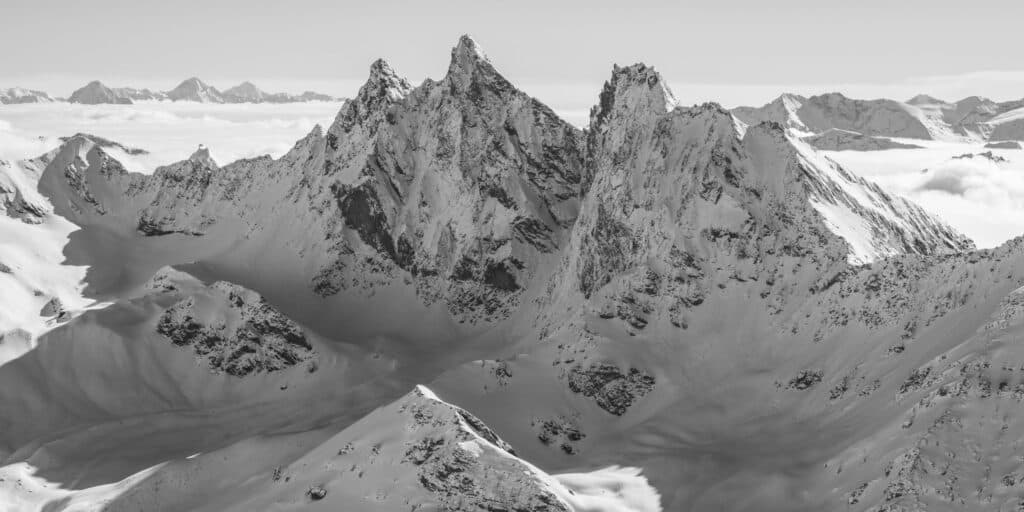
First ascent of the Aiguilles Rouges d'Arolla : in the Swiss Valais
At the crossroads of the Val d'Hérémence and the Val d'Hérens, the Aiguilles Rouges d'Arolla knew neither the breath of man nor his tears. Until that glorious day when Joseph Gillioz and Henri Isler overcame, one by one, the obstacles on their steep slopes.
It was while contemplating this immense mountain range from the heights of Mont Pleureur and La Sâle that Henri Isler felt the supreme desire to be the first to reach its summit. The idea matured within him when, on June 19 1870, Joseph Gillioz, his guide, invited him to follow him into the high mountains. Their expedition began at Fionnay in the Val de Bagnes on June 21. Leaving the valley behind, the mountaineers set off at a brisk pace towards Sovereu. Behind them, the horizon dances in the evening light and the Combins massif greets them, flooding the sky with crimson reflections. The spectacle is grandiose, and encourages them to continue their quest. It's already pitch-dark when they finally reach the chalet at Sovereu. After sharing a frugal meal, they fall asleep hopeful in the hollow of the mountain.
Ascent of the Aiguilles Rouges d'Arolla : On the brink of greatness
On June 22, 1870, Henri Isler and Joseph Gillioz left the refuge at 3:15 a.m. to reach the Écoulaies glacier via the Col de Sovereu. Facing them, the Aiguilles Rouges d'Arolla, with their colossal wingspan, seemed to be watching their every step. Alongside them, the giants of the Valais soar in chorus. The Vouasson and Darbonires peaks, but also, in the distant mist, the Weisshorn, the Mischabel massif, the Rothorn, the Blanc de Moming, the Matterhorn and the peaks of Mont-Rose. So many illustrious summits offering mountaineers a marvellous view of the beauties of the sky.
After a smooth crossing of the Écoulaies glacier, which at that time still ran alongside the Rochers du Bouc, Henri Isler and Joseph Gillioz reached the Lautaret chalet at 9:15 a.m. for a break. Then, determined to cross the first slopes leading to Les Aiguilles, they set off again. In the second half of the 19th century, there was neither Lac des Dix nor the Grande Dixence dam. From the Rochers du Bouc, the climbers headed straight for the northern Col des Darbonires when Henri Isler suddenly felt a touch of altitude sickness. He perseveres with his ascent and keeps believing. But his headaches become so intense that he is forced to turn back.
By giving up their expedition, the climbers know they won't have enough provisions with them to try again the next morning. Their disappointment was immense, but they couldn't bring themselves to give up. Joseph Gillioz, in a burst of energy, offered to take his companion to Hérémence to stock up on supplies. Imagine the incredible vigor of this man, who runs one race after another without ever succumbing to exhaustion!
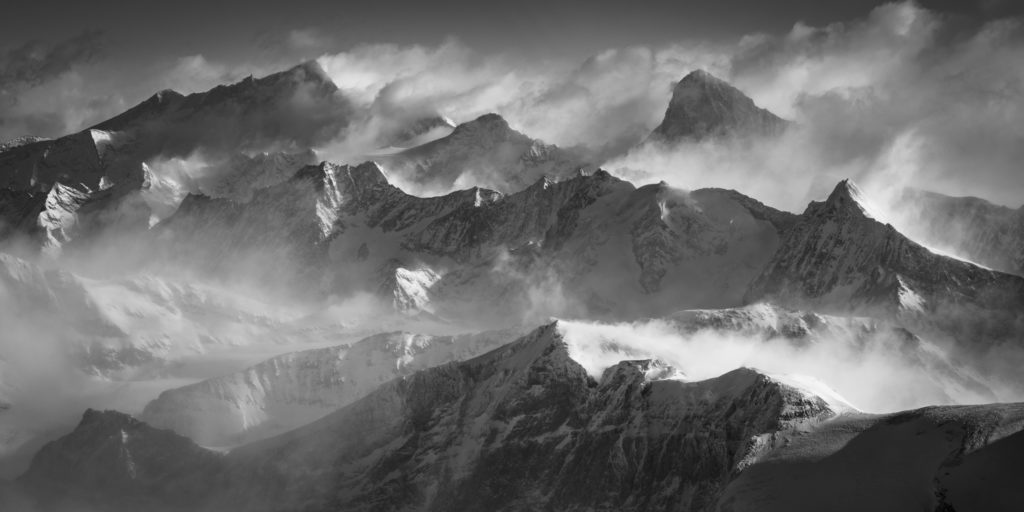
First ascent of Aiguilles Rouges d'Arolla : From Val des Dix to Col Nord des Darbonires
On June 23, 1870, the two men had breakfast and left their bivouac at 5am. They climbed up to the Darbonires glacier, skirting the streams that trickle down to feed the Dixence. Leaving the green slopes behind, they enter a world of rock and ice. At a glance, they admire La Sâle, emerging from the ice to touch the sky. This mountain in the Val de Bagnes, once Henri Isler's first conquest, seems here to encourage them to surpass themselves. On the Darbonires glacier, the ground is hard, devoid of snow. They have to wrest each step from the sharp, uncompromising ice until the snow carries them again. But as they make faster progress, the mountain once again stands in their way. When they reached the foot of the west face of the Aiguilles Rouges d'Arolla, they discovered that no route could be opened there.
Then, resigned, they have to climb up through ice and scree to the north-west ridge of the Aiguilles Rouges. From the top of this ridge, they finally catch sight of the Aiguilles Rouges glacier. In front of them stretches the Val d'Arolla and its sublime relief: the Petite and Grande Dents de Veisivi, the Dents du Perroc and Tsalion, and behind them the Ferpècle and Mont Miné glaciers, feeding the Borgne and its famous torrent. Filled with the splendour of this panorama, the climbers begin their traverse of the Aiguilles Rouges d'Arolla.
The Aiguilles Rouges d'Arolla : Crossing from their northern summit to their main summit
By the time they reached its northern tip, Henri Isler thought he had reached the highest point of this enormous range. But he has not. His audacity leaves him for a moment, leaving him with doubts and bitterness. Will he really be the first to conquer the Aiguilles Rouges in the Val d'Arolla ? A yawning chasm opens up before them, and the sheer rock seems impassable. They have no choice but to descend along the sharp, ragged peak they find themselves on. When they arrive safely at the bottom of the fault that separates them from their objective, they are astonished to discover that here too, the mountain is blocking their path. Huge boulders in unstable equilibrium block the path to the summit. At any moment, they threaten to collapse. For Joseph Gillioz, climbing them was out of the question. So the two men took detours, dodged rocks and avoided dangers. Until they came upon the only possible route to the main summit the Aiguilles Rouges. In snow and ice, they carve out steps, then tread crumbling rock again. Nothing is simple in this adventure.
Solidly attached, the roped party forges ahead, their souls firmly anchored to their bodies. When the Aiguilles Rouges d'Arolla opened up a final gap in front of the men, Joseph Gillioz decided to detach himself and set off to scout beyond the rocks. His companion, who can no longer see him, counts the minutes. Time stretches and the wait seems interminable. He holds his breath and listens, the better to follow his guide's progress from a distance. Suddenly, Gillioz's head emerges from the rocks. Gillioz is alive! He has succeeded and immediately reassures him. The route is passable and, if all goes well, in a few minutes they'll be at the summit.
More united than ever in their fervor, they resume their ascent and set foot on the summit the Aiguilles Rouges d'Arolla at 1:40pm. Together, they achieved the feat of being the first to conquer this gigantic mountain. Together, they have overcome the worst obstacles. Their howls of joy echoed across the Alps. From summit to summit, the news spread like a perfume of glory. With moist eyes and beating hearts, they admire the beauty of the earth around them. All those mountains that make them dream.
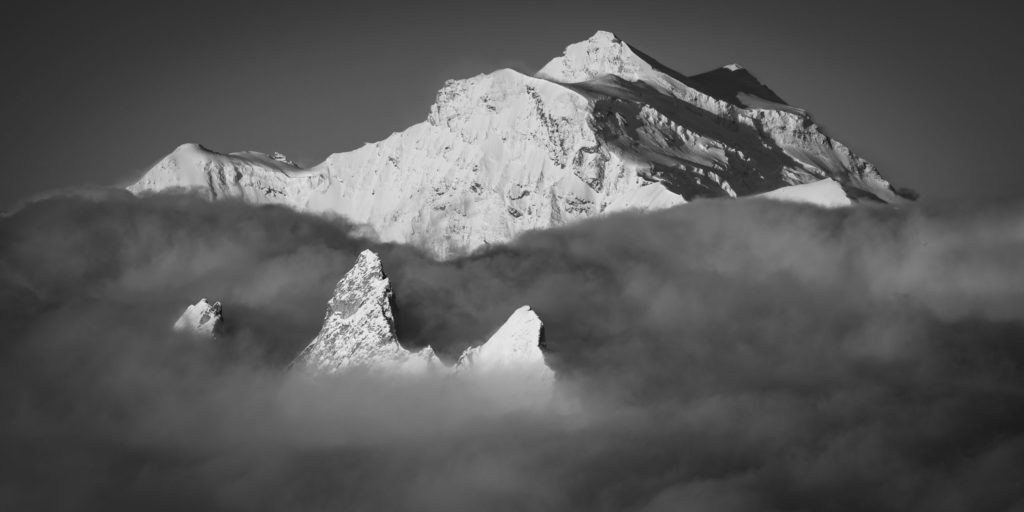
Aiguilles Rouges d'Arolla ascent: a perilous descent at the gates of Hérémence
They don't yet dare to believe in their prowess when they're already forced to come down. Up there, you think you're out of time, but reality soon catches up with you. Henri Isler and Joseph Gillioz leave the Aiguilles Rouges d'Arolla summit at 2:27 pm. They hurried forward, as rock falls became more numerous as the sun warmed the eternal snows. Step by step, they progress with fear in their stomachs, as the rocks are unstable and the wall slippery. It's only when they reach the Darbonires glacier that they can finally catch their breath, relieved to be alive and to have overcome this final ordeal. Night falls when they reach the pastures and the Lautaret refuge.
It's 8 p.m. and reason would have them sleep at the foot of the Aiguilles Rouges. But their desire to blend back into the human world is stronger than anything. The mountaineers set off on a final run to Hérémence. But they soon lose their way, at the crossroads of the Praz-Fleury and Dixence glaciers. It's far too dark to see where they're going, and the path they're supposed to follow is desperately elusive. What next? Mount Blâva and the Pointe de la Vouasson above them could do nothing to help. It occurred to them to get closer to the Dixence. The trail should be nearby. They groped around in the dark, probing the terrain with their sticks, making sure not to trip. Suddenly, they see a hut just a few meters away. It seemed inhabited. They rush in and are welcomed by its occupants around a roaring fire. It's 10 p.m. when they finally get some rest.
The next morning, they left their hosts for Hérémence, then Vex, and parted company in Sion at midday. They're not about to forget their journey, and they're all the stronger for their victory. For no one else can claim to have made the first ascent of the Aiguilles Rouges d'Arolla.
Portrait of the Aiguilles Rouges d'Arolla : Records in the skies above the Valais Alps
More feats followed at the summit the Aiguilles rouges d'Arolla. On September 9, 1882, Adolph and Franz Andermatten, Reginald Hughes and D. W. Stable were the first to climb the central peak via its southeast face. Robert Cary Gilson and Pierre Maître made the first ascent of the west-facing peak on August 19, 1890.
The southern summit of the Aiguilles Rouges d'Arolla was conquered on September 3, 1887. Arthur Macnamara, Jean Maître, William Cecil Slingsby and Harold Ward Topham climbed this southern peak via its east face and south ridge, before descending via its northeast ridge. They then continue their journey by crossing the central summit the Aiguilles Rouges from south to north. They then open the way for the more courageous to embark on a full traverse of the mountain range.
Today, the most popular route takes climbers across the three summits the Aiguilles Rouges d'Arolla from north to south. From the Aiguilles Rouges hut, perched at 2815 m, the journey is prodigious and the experience unforgettable.
The Aiguilles Rouges d'Arolla , a wild mountain range lost in the heart of the Swiss Alps, became the scene of exceptional adventures. Thanks to the audacity of a handful of men, they have entered the spotlight. Of course, this mountain doesn't rise to 4000 m, but it undoubtedly possesses the charisma and magnificence of the greatest.
